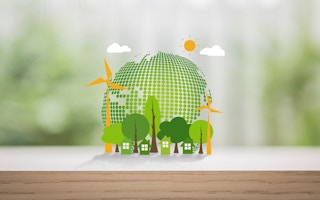Over the past decade, thought leaders and technology innovators have been developing new supply chain structures, production technologies and delivery systems. These principles, strategies, technologies and practices are solutions designed to increase business profits, build community resilience and enable ecosystem regeneration. One of the leading movements in this area is that of The Blue Economy.
To continue reading, subscribe to Eco‑Business.
There's something for everyone. We offer a range of subscription plans.
- Access our stories and receive our Insights Weekly newsletter with the free EB Member plan.
- Unlock unlimited access to our content and archive with EB Circle.
- Publish your content with EB Premium.
The Blue Economy, as outlined by Professor Gunter Pauli in his Report to the Club of Rome (now in 38 languages), is set to generate 100 million new jobs in the next 10 years, based on more than a hundred innovations. These are all led by physics and inspired by nature, producing goods while generating zero waste, and intended to support a world guided by the Kyoto Protocol.
The Blue Economy is already delivering a new era of economic prosperity. It combines a tested framework for economic development and leading emerging technologies and principles for innovation delivery. It is a new way of developing sustainable, rewarding business opportunities. This is why as Founder and CEO of Models of Success and Sustainability (MOSS), the industry body for CSR and Sustainability in Australia, I went last year to Hungary - the only place in the world currently offering such courses - to study the Blue Economy.
This concept was seeded by the UN University in 1994 (3 years prior to the adoption of the Kyoto Protocol) to develop a competitive business model for a world guided by the Protocol and it’s now creating jobs, solving problems, and teaching us to be more entrepreneurial and collaborative in working with what we have.
Some think the Blue Economy is just another version of the Circular Economy – as both stand on the shoulders of the green economy to achieve radical resource productivity, zero waste and sustainability. They also both incorporate concepts such as systems thinking and design, cradle-to-cradle, closed loop, up-cycling, reuse, recycling, remanufacturing, industrial ecology, renewable energy and the sharing economy.
However, the Blue Economy goes further; it shifts away from the concept of a core business/competence that force companies to focus on one industry, and towards considering local economic development as a priority, ensuring that local purchasing power increases and more money circulates regionally.
This enables growth without inflation through an increase in local production of goods and services - so it’s no surprise that the early adopters of the Blue Economy are not multinationals, but local, state and federal governments, community groups, entrepreneurs and SMEs,
In addition to its cascading business models, the Blue Economy supports Global Progress Indicators (GPI) rather than GDP. GPI is a more accurate measure of economic activity whereas GDP makes no attempt to factor in the depletion of natural resources, natural disasters or degradation of the environment.
“
The Blue Economy goes further; it shifts away from the concept of a core business/competence that force companies to focus on one industry, and towards considering local economic development as a priority, ensuring that local purchasing power increases and more money circulates regionally.
It is guided by 21 explicit principles and supported by around 3000 scientists worldwide who are part of Zero Emissions Research and Initiatives (ZERI); they have spent 20 years examining new energy, building and design options to deliver more than a hundred multi-application innovations. Organisations can draw from this screened set of innovations to create jobs, not just provide efficiency.
An example of this is the Vortex Processing Technology (VPT) – a multi-application innovation by Watreco of Sweden. Their VPT and Industrial Vortex Generators (IVG) change the properties of water. They crystallize lime particles, remove air bubbles, decrease viscosity and increase both electrical conductivity and heat capacity.
When used in cooling towers and evaporative condensers, VPT achieves higher efficiency and longer product life span because lime-scale deposits no longer build up around the cooling elements. In combination with UV-light to prevent biological growth, the IVG-CT can achieve a 100 per cent non-chemical cooling plant. The “blow down” water can be re-used without treatment a second time before being released.
By using VPT in cooling towers and evaporative condensers, we replace something (chemicals) with nothing and generate multiple benefits such as energy and chemical-free water. These are key principles of Blue Economy design. We also create additional value by increasing the life-span of the equipment, reducing environmental impacts, and enabling the water to be used for other purposes. These gains are part of the design, right from the start.
In regions where water is scarce and energy efficiency is paramount, we are seeing governments such as California and the EU giving incentives to business and industry to use this technology. But even without incentives, it’s still a great business case with a pay-back period of less than two years.
Companies such as brewer Heineken, dairy Friesland Campina, chemical manufacturer Huntsman Corp and cooling systems specialist Soest Cooling are achieving significant savings by using an IVG-CT system in their cooling towers.
VPT is also relevant for mining, the paint and coating industry, the cement industry, oil production and recovery, algae control, aeration and waste treatment, process mixing and separation.
To date, the Blue Economy has seen over 4 billion euros in investment and the creation of an estimated 3 million jobs with innovation and technology that is as diverse as it is game changing.
Some examples include things like thistles – yes, waste that we spend millions trying to kill with expensive toxic chemicals – can be turned into valuable oils. Novamont’s Sardinia Refinery, for example, saw $600 million in revenues in its first year.
Coffee waste can be used as a valuable substrate to grow mushrooms and prevent shoes and sports clothes from becoming smelly; and mining waste can be turned into stone paper - paper that needs no trees or water in its manufacturing process that can be recycled forever. Its mills can cost around 40 per cent less than a traditional paper pulp mill.
Surely we owe it to ourselves to go beyond the current status quo, to learn profitable new ways of doing business that work in harmony with nature. So is blue the new green? I think so.
Anne-Maree Huxley is sustainability advisor and an expert on the Blue Economy. She’s the founder and chief executive officer of Models of Success and Sustainability (MOSS) and the founder of the Blue Economy Institute.









